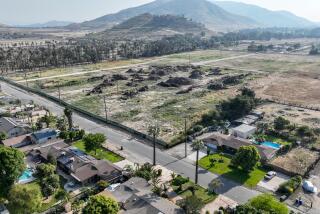‘We’re Not Doing This to Stop the No-Growthers’ : Builders Tackling Their Image Troubles
- Share via
San Diego County’s building industry Monday launched an ambitious effort to find solutions to growth-related problems that have hurt the industry’s image with the public.
Industry leaders said a key part of the plan will be to persuade skeptical community and environmental activists that the industry is interested as much in the quality of its work as in the quantity.
The effort, known as “Progress ‘87,” comes on the heels of a new political strategy designed to enlist rank-and-file industry workers in the campaigns of candidates seen as friendly--or at least open--to the industry.
But at least two members of the Sierra Club, the county’s most prominent environmental group, said they are skeptical of the building industry’s intentions.
Although the project comes as the City of San Diego and the county Board of Supervisors begin similar reviews of growth and its effects on the region, builders said their work will add to, rather than compete with, the government plans.
“We as builders are in a unique position because we deal with the challenges of accommodating growth in every part of this county,” said Michael Reynolds, president-elect of the county Building Industry Assn. “We are firmly convinced that the answers to how to accommodate growth are regional . . . and not at any one political jurisdiction.”
The industry’s program creates four task forces of builders, experts and community residents interested in growth. The task forces will study problems associated with traffic congestion, school overcrowding, the provision of public facilities and general concerns about development.
The four topics were chosen after builders commissioned a survey of 150 community leaders from planning groups, school boards, PTAs, senior citizen groups and civic organizations. The survey identified traffic as by far the most serious concern. About 90% of the respondents described increased traffic as a “major” or “critical” problem.
Other concerns include declining sewer and water capacity, overcrowded schools, increased housing density and air pollution.
According to a schedule released by the builders, each group will meet monthly from February to September. In October, the results will be released.
BIA President Dennis Russell insisted that the project is not aimed at defusing anti-growth sentiment that has resulted in citizen initiatives to control development in San Diego and Carlsbad, and talk of such moves in other communities.
“We’re not doing this to stop the no-growthers,” Russell said. “We’re trying to find ways to continue San Diego’s growth in a manner we can all live with.”
But Ruth Duemler, chairwoman of the Sierra Club, said the industry is reacting to the slow-growth movements, a reaction she said was long overdue.
“If they want to continue to do business in San Diego County, they’re going to have to do something like this,” Duemler said. “I’m sorry they didn’t start 20 years ago.”
Lynn Benn, chairwoman for land use for the Sierra Club and one of those who responded to the industry’s survey, said she wonders whether the industry truly seeks solutions or simply hopes to turn around public opinion. In the long run, she said, the industry’s image will be hurt more if the effort is not genuine.
“If they are in fact reaching out to the communities to look for solutions to tough problems, then I hope we all sit down with them and look for solutions,” said Benn, who is also chairwoman of the Torrey Pines community planning group. “But if in fact they are doing a public relations job and trying to change an image they’ve created, a very negative image, and nothing substantive comes out of this, then I think that’s going to be even more unfortunate.”
Robert L. Santos, senior vice president of Eastlake Development Co. and one of the four task force chairmen, said the project will be a “sincere effort.”
“It’s important that it not be one of those studies that is filed on the shelf and that people point to and say, ‘See, we’ve done our duty,’ ” he said. “If you expect to find silver bullet solutions, we’re not going to find those, but we expect to find solutions we can work toward over the long term.”
The other task forces will be headed by Julie Dillon, president of Dillon Development; Michael Madigan, senior vice president of Pardee Construction Co., and Barry McComic, chairman of McComic Inc.
More to Read
Inside the business of entertainment
The Wide Shot brings you news, analysis and insights on everything from streaming wars to production — and what it all means for the future.
You may occasionally receive promotional content from the Los Angeles Times.









